Study on the Stability of Cut Slopes Caused by Rural Housing Construction in Red Bed Areas: A Case Study of Wanyuan City, China
Abstract
:1. Introduction
2. Study Area
2.1. Overview of the Study Area
2.2. Characteristics of Cut Slopes
2.3. Factors on the Cut Slope Stability
2.4. Typical Slope Cutting Sites
3. Materials and Methods
3.1. Establishment of Constitutive Model
3.2. Geological Parameter Values
3.3. Numerical Model Construction of Typical Cut Slopes
- Model area setting: To control a single variable, the main profile of the cut slope was selected as the model area, the slope height of soil slope was set to be 35 m, and the slope height of rock–soil mixed slope was set to be 40 m. Slope models with different slope gradients were constructed by changing the horizontal distance from the toe to the top of slope, and the different slope cutting conditions were simulated by changing the excavation heights at the toe of the slope.
- Determination of the constitutive model: The soil slope was generalized as a Mohr–Coulomb model composed of homogeneous eluvial silty clay layers. The rock–soil mixed slope was generalized as a Mohr–Coulomb model consisting of a eluvial silty clay layer and moderately weathered sandstone bedrock.
- Boundary condition setting: The model had no horizontal displacement in the ordinate direction and no vertical displacement in the abscissa direction.
- Regional grid division: To ensure the best precision, accuracy, and calculation speed of the finite element method, the grid spacing was set to 1 m, and quadrilateral and triangular elements were used to connect the two materials in the transition area, so that each area of the model was divided into multiple independent cells.
3.4. Numerical Simulation of Different Slope Cutting Conditions
4. Results
4.1. Numerical Simulation Results
4.2. Stress–Strain Redistribution Caused by Slope Cutting
5. Discussion
5.1. Disaster-Causing Cut Slope Failure Mode
5.2. Influence of Slope Cutting Height on Slope Stability
5.3. Critical and Recommended Values of Slope Cutting Height
5.4. Engineering Implications
- Before cutting the slope, the geological data should be collected, and a detailed engineering survey should be carried out to obtain topographic data, a geological investigation on internal and external factors affecting cut slope stability must be conducted carefully, and detailed engineering plans and sections should be drawn out; a safe and feasible slope cutting scheme should be formulated. Because the slope cutting project has certain dangers, it is necessary to hire a professional construction team to cut slopes.
- As shown in Table 4. For soil slope, the critical cut height values were 6.3 m, 6.2 m, 5.2 m, and 2.6 m at slope of 10°, 20°, 30° and 40°, respectively. For the rock–soil mixed slopes, the critical cut height values were 6.5 m, 5.9 m, and 2.2 m at a slope of 20°, 30° and 40°, respectively. If the actual cut height value is exceeded, the slope may become unstable. When the natural slope gradient is 30 or 40, there is no recommended value for the slope cutting height. In addition, the critical and recommended values are suitable when the slope gradient and lithology composition are simple. And if the topography or lithology is complex, it is necessary to construct a detailed numerical model and simulate actual cut slope stability.
- After cutting the slope, the protective measures in the slope cutting area should be paid attention to. The protective measures should be based on the principle of prevention and combine environmental protection and engineering treatment. Protective measures should be based on the stability requirements of the cut slope and refer to the existing local engineering experience. The construction scheme should be economical and feasible, with strong operability. Protective measures should pay attention to the drainage and treatment of surface water and groundwater. The cut area should be strengthened by using a dry blocks, concrete retaining wall, mortar blocks, or other methods.
6. Conclusions
- Based on the field investigation of 76 slope cutting sites caused by rural housing construction, it is found that the internal factors affecting the stability of cutting slope mainly include the slope type, lithologic composition of slope, and natural slope gradient, and the external factors include the cut slope height, cut slope gradient, and protection engineering.
- The stability coefficient and stress–strain distribution of the cut slope under different working conditions were obtained by numerical simulation of two typical cut slopes. It is clear that the horizontal stress and strain at the toe of the cut slope with different natural slope gradients are positively correlated with the slope cutting height. The greater the slope gradient is, the higher the height of slope cutting is, and the more the horizontal stress increases.
- Slope cutting greatly influenced redistribution of stress and strain in the slope body. For the soil slope, the stress at the slope toe was unloaded after slope cutting, and the maximum stress and strain values appeared in the slope toe area. The rock–soil mixed slope went through two stages: soil and rock cutting. After cutting to the bedrock surface, the maximum stress and strain values appeared at the intersection area of the soil–rock interface and slope cutting surfaces.
- There are three main failure modes of shallow landslide caused by slope cutting: (1) the collapse of soil and rock at the top of the cut slope; (2) the creeping of residual soil on the surface of the slope; and (3) the sliding of the Quaternary overburden down the rock–soil interface. Slope cutting activities accelerate the evolution process of slope landform.
- In this paper, the fitting functions of the cutting height and stability coefficient were used to determine the critical and recommended values of the slope cutting height. For the soil slope, the critical cut height values were 6.3 m, 6.2 m, 5.2 m, and 2.6 m at a slope of 10°, 20°, 30° and 40°, respectively. For the rock–soil mixed slopes, the critical cut height values were 6.5 m, 5.9 m, and 2.2 m at a slope of 20°, 30°, and 40°, respectively. Generally speaking, the fitted function relationship could be used to predict the stability of a slope after slope cutting.
Author Contributions
Funding
Informed Consent Statement
Data Availability Statement
Acknowledgments
Conflicts of Interest
References
- Du, X.; Hao, F.; Cao, J. Analysis of slope stability under the condition of cutting forhouse-building. Chin. J. Geol. Hazard Control 2020, 31, 40–47. [Google Scholar]
- Gao, M.B.; Zhang, H.; Cui, S.H.; Wu, Z.T.; Liu, J.; Feng, L.X. Investigation on deformation mechanism and treatment effect of a scattered slopebased on continuum–discontinuum element method and finite difference method. Front. Earth Sci. 2022, 10, 894923. [Google Scholar] [CrossRef]
- Yuangui, P.; Chen, K.; Gao, M.; Wu, Z.; Zheng, G.; He, Q.; Lu, F.; Wan, Y.; Du, C.; Cao, N.; et al. Study on the threshold value of disaster-causing factors of engineering slope cutting in red-layer areas. Front. Earth Sci. 2022, 10, 961615. [Google Scholar]
- Cui, S.; Pei, X.; Jiang, Y.; Wang, G.; Fan, X.; Yang, Q. Liquefaction within a bedding fault: Understanding the initiation and movement of the daguangbao landslide triggered by the 2008 wenchuan earthquake (ms = 8.0). Eng. Geol. 2021, 295, 106455. [Google Scholar] [CrossRef]
- Li, H. Short-term wind power prediction via spatial temporal analysis and deep residual networks. Front. Energy Res. 2022, 10, 920407. [Google Scholar] [CrossRef]
- Liu, W.; Hu, Y.X.; He, S.M.; Zhou, J.W.; Chen, K.T. A numerical study of the critical threshold for landslide dam formation considering landslide and river dynamics. Front. Earth Sci. 2021, 9, 651887. [Google Scholar] [CrossRef]
- Shepheard, C.J.; Vardanega, P.J.; Holcombe, E.A. Analysis of design choices for a slope stability scenario in the humid tropics. Proc. Inst. Civ. Eng. Eng. Sustain. 2017, 171, 37–52. [Google Scholar] [CrossRef]
- Guzzetti, F.; Carrara, A.; Cardinali, M. Landslide hazard evaluation:A review of current techniques and their application in a multi-scale study, Central Italy. Geomorphology 1999, 31, 181–216. [Google Scholar] [CrossRef]
- Su, L.; Hu, K.; Zhang, W.; Wang, J.; Lei, Y.; Zhang, C.; Cui, P.; Pasuto, A.; Zheng, Q. Characteristics and triggering mechanism of Xinmo landslide on 24 June 2017 in Sichuan, China. J. Mt. Sci. 2017, 14, 1689–1700. [Google Scholar] [CrossRef]
- Wang, H.B.; Sassa, K.; Xu, W.Y. Analysis of a spatial distribution of landslides triggered by the 2004 Chuetsu earthquakes of Niigata Prefecture, Japan. Nat. Hazards 2007, 41, 43–60. [Google Scholar] [CrossRef]
- Strouth, A.; McDougall, S. Historical landslide fatalities in British columbia, Canada: Trends and implications for risk management. Front. Earth Sci. 2021, 9, 1–8. [Google Scholar] [CrossRef]
- Panthee, S. Parametric evaluation of shear strength parameters on thestability of cut slope: A case study from mahabaleshwar road section, India. J. Nepal Geol. Soc. 2016, 51, 73–76. [Google Scholar] [CrossRef]
- He, L.; Ren, Y.; Feng, Z.X.; Han, Z.W. Numerical simulation and Design optimization research of slope ratio and platforms influence on a high rock cut slope engineering stability. Adv. Mat. Res. 2014, 1065–1069, 151–158. [Google Scholar] [CrossRef]
- Cao, C.S.; Wu, S.R.; Pan, M.; Liang, C.Y. Mechanism research on artificial slope cutting-induced loess landslide. Rock Soil Mech. 2016, 37, 1049–1060. [Google Scholar]
- Qin, C.A.; Chen, G.Q.; Zhu, J.; Tang, P. A precursor of bedding rock slide: Rock spalling in the key block triggered by tensile cracks. Bull. Eng. Geol. Environ. 2020, 79, 2513–2528. [Google Scholar] [CrossRef]
- Zhang, W.C.; Wang, D. Stability analysis of cut slope with shear band propagation along a weak layer. Comput. Geotech. 2020, 125, 103676. [Google Scholar] [CrossRef]
- Ai, X.Y.; Wang, L.; Xu, D.P.; Rong, J.J.; Ai, S.; Liu, S. Stability of artificial soil aggregates for cut slope restoration: A case study from the subalpine zone of southwest China. Soil Tillage Res. 2021, 209, 104934. [Google Scholar] [CrossRef]
- Zhou, J.; Wei, J.; Yang, T.; Zhang, P.; Liu, F.; Chen, J. Seepage channel development in the crown pillar: Insights from induced microseismicity. Int. J. RockMech. Min. Sci. 2021, 145, 104851. [Google Scholar] [CrossRef]
- Awang, H.; Salmanfarsi, A.F.; Aminudin, M.S.; Ali, M.I. Stability of weathered cut slope by using kinematic analysis. IOP Conf. Ser. Earth Environ. Sci. 2021, 682, 012018. [Google Scholar] [CrossRef]
- Shao, Y.L.; Yang, H.R.; Wang, J.J.; Yang, Y. Deformation evolutionprocess of a gently inclined red-bed slope influenced by cutting. Adv. Sci. Technol.Water Resour. 2022, 42, 95–100. [Google Scholar]
- Li, H.; Deng, J.; Feng, P.; Pu, C.; Arachchige, D.; Cheng, Q. Short-term nacelle orientation forecasting using bilinear transformation and ICEEMDAN framework. Front. Energy Res. 2021, 9, 780928. [Google Scholar] [CrossRef]
- Li, H.; Deng, J.; Yuan, S.; Feng, P.; Arachchige, D. Monitoring and identifying wind turbine generator bearing faults using deep belief network and EWMA control charts. Front. Energy Res. 2021, 9, 799039. [Google Scholar] [CrossRef]
- Kaya, A.; Akgün, A.; Karaman, K.; Bulut, F. Understanding the mechanism of slope failure on a nearby highway tunnel route by different slope stability analysis methods: A case from NE Turkey. Bull. Eng. Geol. Environ. 2015, 75, 945–958. [Google Scholar] [CrossRef]
- Yan, T.; Xiong, J.; Ye, L.; Gao, J.; Xu, H. Field Investigation and Finite Element Analysis of Landslide-Triggering Factors of a Cut Slope Composed of Granite Residual Soil: A Case Study of Chongtou Town, Lishui City. Sustainability 2023, 15, 6999. [Google Scholar] [CrossRef]
- GB/T 50123–2019. Ministry of Housing and Urban Rural Development of the People’s Republic of China (MHURD-PRC) “Chinese Standard for Geotechnical Testing Method”. China Planning Press: Beijing, China, 2019.

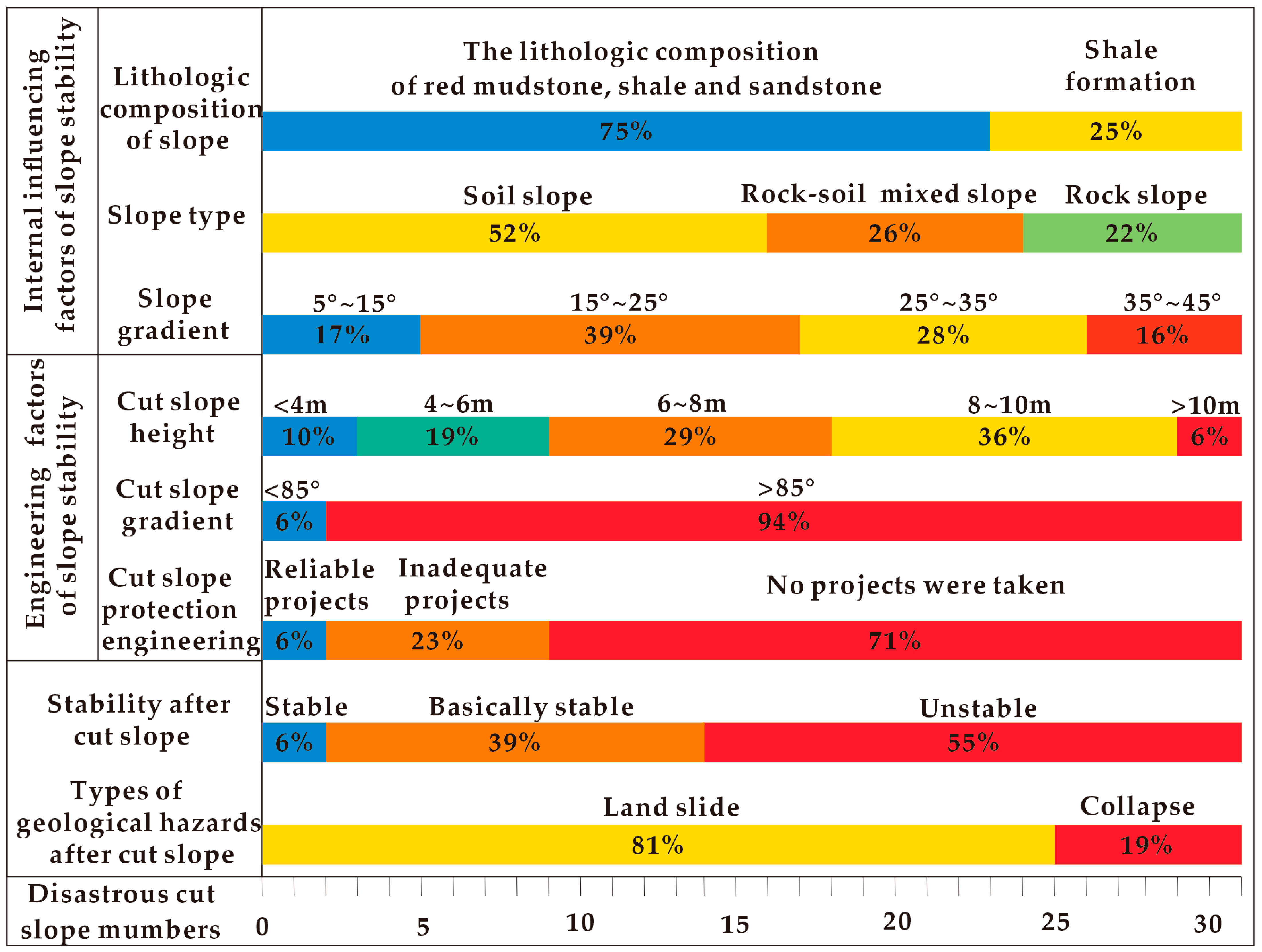

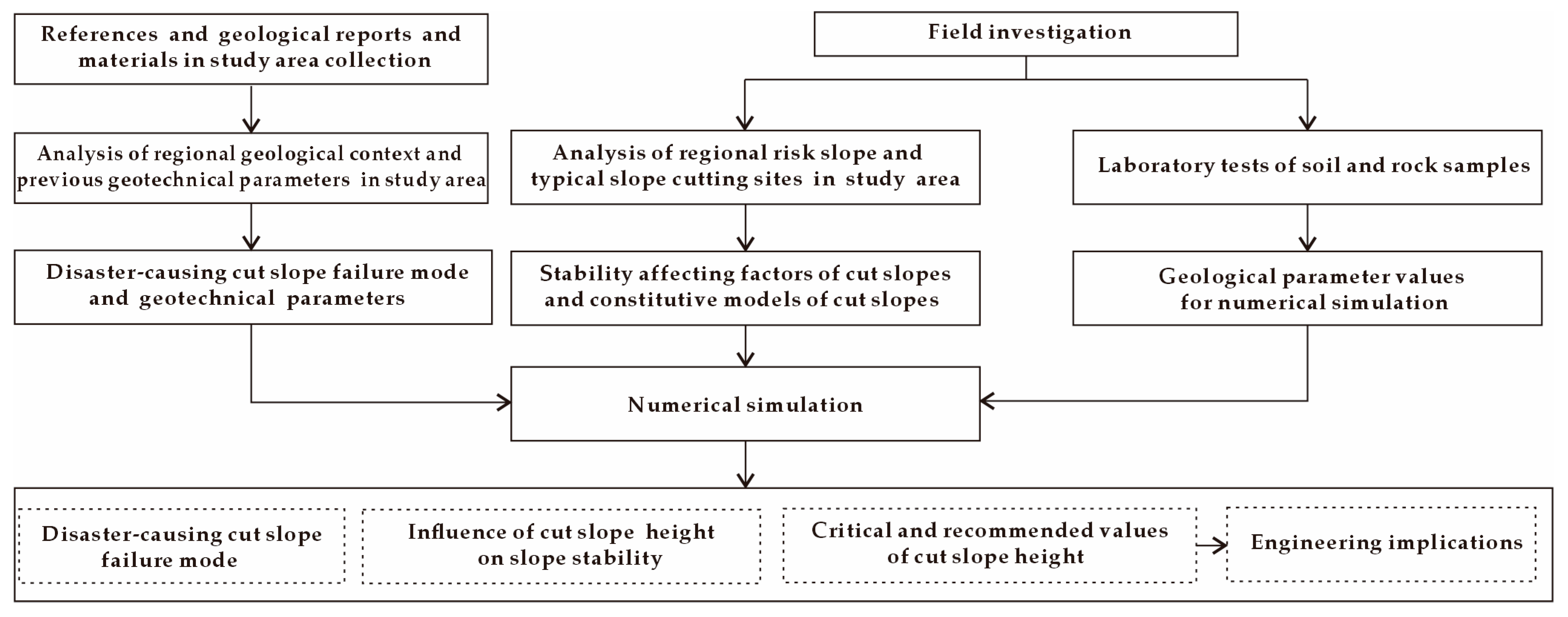

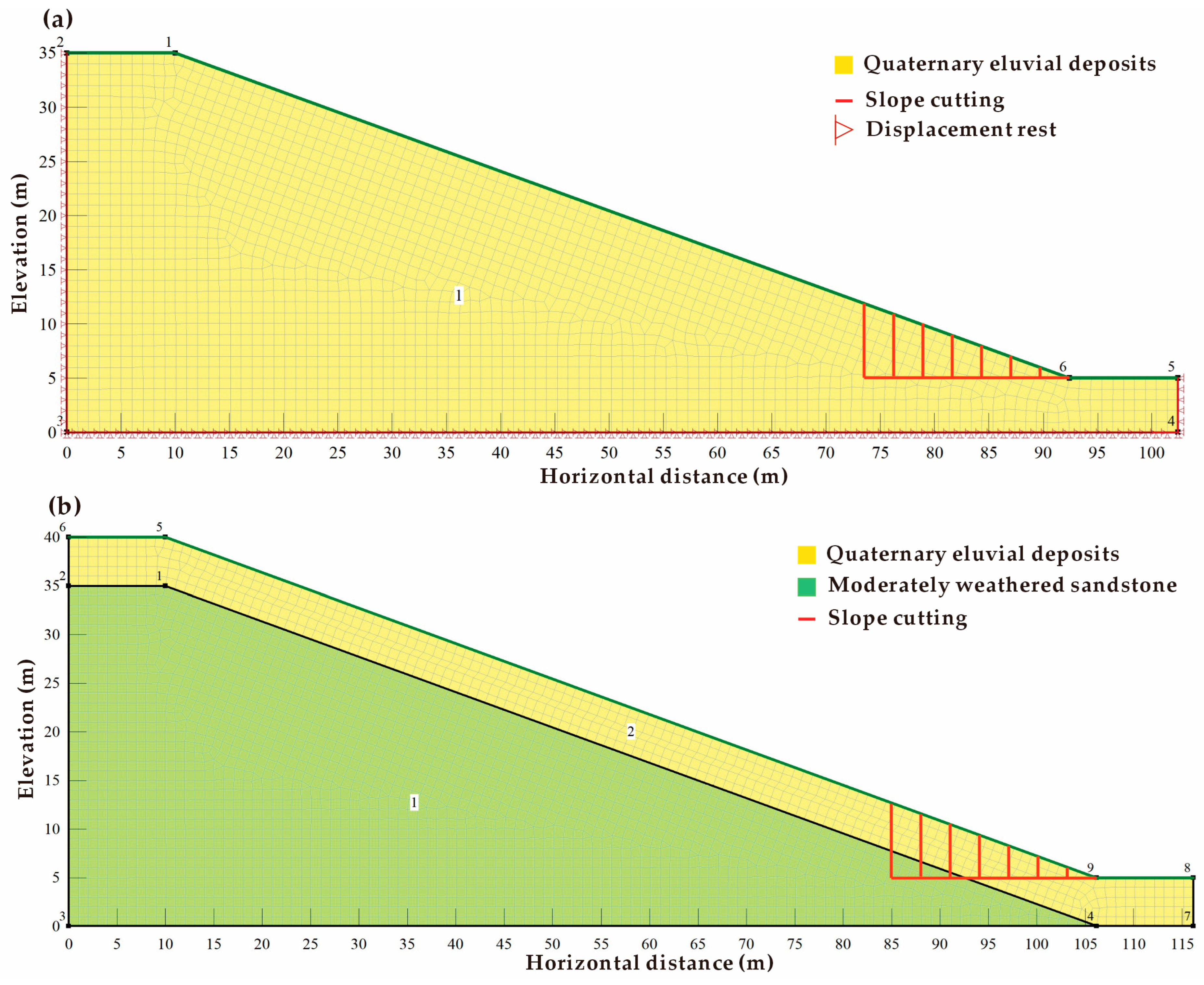
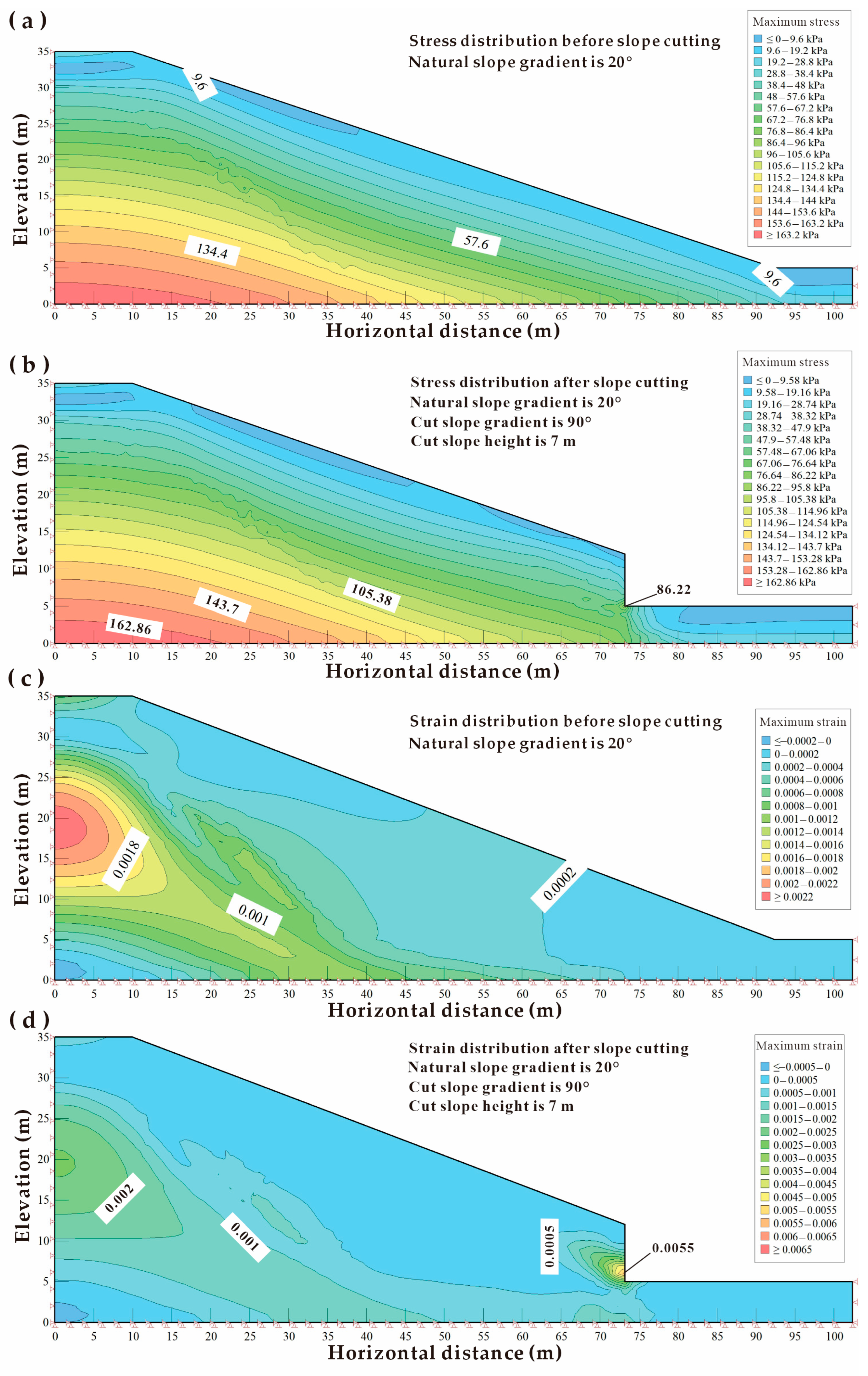

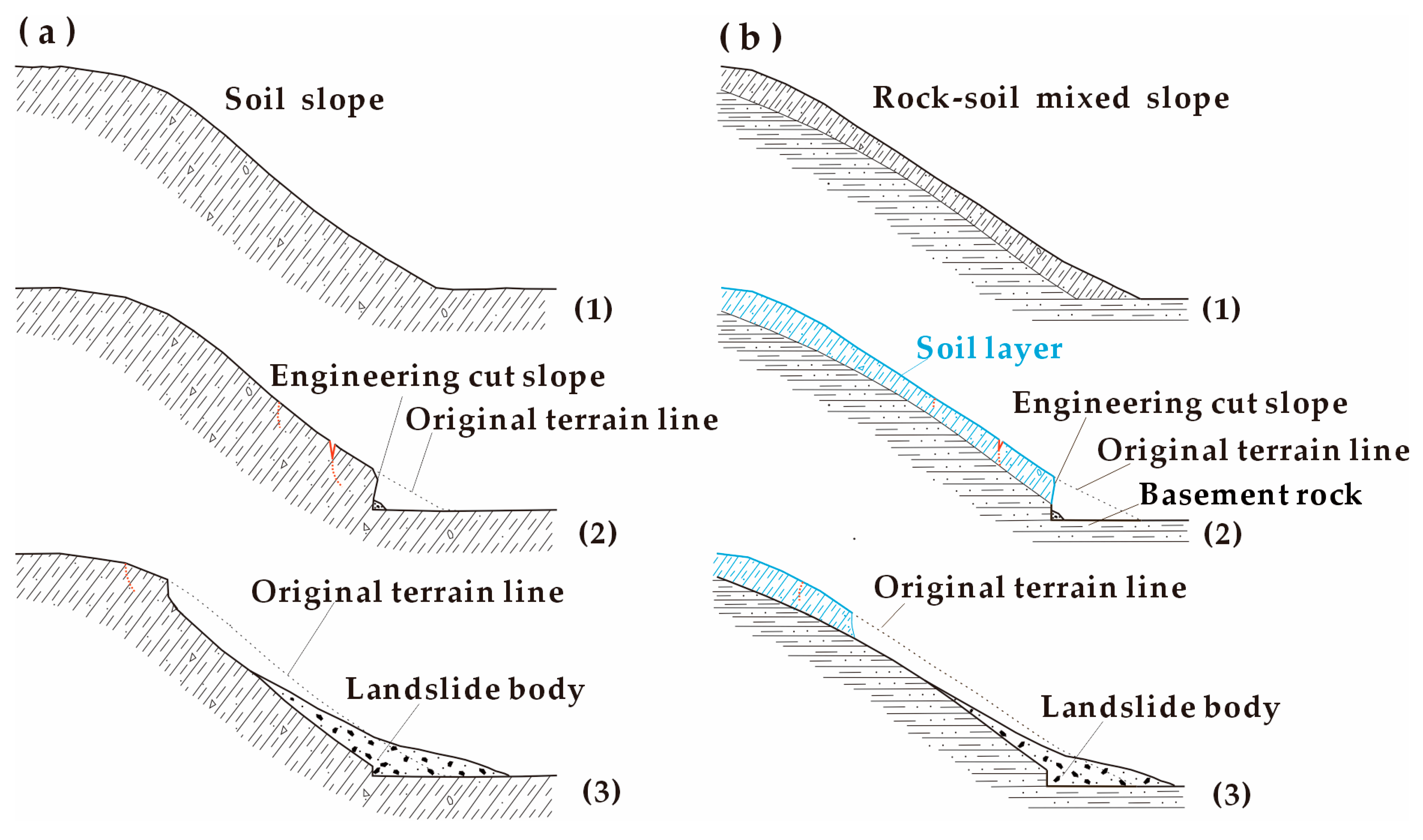

| Materials | Density (KN/m3) | Cohesion (Kpa) | Internal Friction Angle (°) | Poisson’s Ratio | Elastic Modulus (Mpa) |
|---|---|---|---|---|---|
| Eluvial silty clay | 18.5 | 18 | 21.5 | 0.3 | 30 |
| Moderately weathered sandstone | 25.7 | 2750 | 39.6 | 0.25 | 7000 |
| Gradient of Natural Slope/(°) Horizontal Stress Values/(kp) Cut Height/(m) | 0 | 1 | 2 | 3 | 4 | 5 | 6 | 7 | |
|---|---|---|---|---|---|---|---|---|---|
| Soil slope | 10° | 8.4 | 14.2 | 18.4 | 28.8 | 34.5 | 40.1 | 47.1 | 55.4 |
| 20° | 9.6 | 19.2 | 28.7 | 47.9 | 57.5 | 65.3 | 76.6 | 86.2 | |
| 30° | 38.3 | 51.3 | 65.7 | 79.6 | 92.3 | 105.3 | 112.6 | 137.6 | |
| 40° | 47.9 | 57.5 | 67.0 | 86.2 | 105.3 | 117.4 | 134.1 | 153.2 | |
| Rock–soil mixed slope | 10° | 6.7 | 7.5 | 8.6 | 10.1 | 13.2 | 18.0 | 23.2 | 31.5 |
| 20° | 10.2 | 15.4 | 23.8 | 32.5 | 40.3 | 46.0 | 53.2 | 66.4 | |
| 30° | 20.2 | 38.2 | 61.4 | 82.9 | 101.7 | 123.5 | 142.8 | 155.7 | |
| 40° | 38.2 | 67.9 | 99.7 | 115.2 | 147.8 | 162.5 | 183.2 | 201.5 | |
| Gradient of Natural Slope/(°) Stability Coefficients Cut Height/(m) | 0 | 1 | 2 | 3 | 4 | 5 | 6 | 7 | |
|---|---|---|---|---|---|---|---|---|---|
| Soil slope | 10° | 2.853 | 2.536 | 2.224 | 1.941 | 1.381 | 1.174 | 1.009 | 0.956 |
| 20° | 1.601 | 1.596 | 1.577 | 1.467 | 1.249 | 1.162 | 1.005 | 0.898 | |
| 30° | 1.128 | 1.124 | 1.097 | 1.087 | 1.055 | 1.023 | 0.993 | 0.835 | |
| 40° | 1.047 | 1.034 | 1.002 | 0.964 | 0.869 | 0.745 | 0.677 | 0.278 | |
| Rock–soil mixed slope | 10° | 3.865 | 3.654 | 3.326 | 3.155 | 2.865 | 2.550 | 2.123 | 1.895 |
| 20° | 2.223 | 2.111 | 1.949 | 1.756 | 1.534 | 1.281 | 1.025 | 0.945 | |
| 30° | 1.238 | 1.219 | 1.193 | 1.159 | 1.117 | 1.066 | 0.977 | 0.932 | |
| 40° | 1.048 | 1.037 | 1.008 | 0.974 | 0.932 | 0.884 | 0.901 | 0.887 | |
| Slope Type | Gradient of Natural Slope | Fitting Function of Cut Slope Height and Stability Coefficient | Critical Value of Cut Slope Height (m) | Recommended Value of Cut Slope Height (m) |
|---|---|---|---|---|
| Soil slope | 10° | y = 0.0203x2 − 0.435x + 2.9271 | 6.3 | 5.0 |
| 20° | y = −0.0101x2 − 0.0402x + 1.6375 | 6.2 | 4.5 | |
| 30° | y = −0.0072x2 + 0.0153x + 1.1156 | 5.2 | no solution | |
| 40° | y = −0.0204x2 + 0.0469x + 1.0193 | 2.6 | no solution | |
| Rock–soil mixed slope | 10° | y = −0.0097x2 − 0.2185x + 3.8638 | 9.3 | 8.6 |
| 20° | y = −0.0049x2 − 0.1631x + 2.2603 | 6.5 | 5.3 | |
| 30° | y = −0.0046x2 − 0.0128x + 1.2378 | 5.9 | no solution | |
| 40° | y = −0.0001x2 − 0.0242x + 1.0548 | 2.2 | no solution |
| Slope Type | Gradient of Natural Slope | Critical Value of Cut Slope Height Determined by Fitting Function (m) | Stability Coefficient Determined by Fitting Function | Stability Coefficient Re-Simulated by Geo Studio Software | Comparison of Two Kinds of Stability Coefficient |
|---|---|---|---|---|---|
| Soil slope | 10° | 6.3 | 1.0 | 1.025 | 2.44% |
| 20° | 6.2 | 1.0 | 1.035 | 3.38% | |
| 30° | 5.2 | 1.0 | 1.023 | 2.25% | |
| 40° | 2.7 | 1.0 | 0.991 | −0.90% | |
| Rock–soil mixed slope | 10° | 9.3 | 1.0 | 2.152 | 53.53% |
| 20° | 6.5 | 1.0 | 1.075 | 6.98% | |
| 30° | 6.0 | 1.0 | 1.021 | 2.06% | |
| 40° | 2.2 | 1.0 | 0.993 | −0.70% |
Disclaimer/Publisher’s Note: The statements, opinions and data contained in all publications are solely those of the individual author(s) and contributor(s) and not of MDPI and/or the editor(s). MDPI and/or the editor(s) disclaim responsibility for any injury to people or property resulting from any ideas, methods, instructions or products referred to in the content. |
© 2024 by the authors. Licensee MDPI, Basel, Switzerland. This article is an open access article distributed under the terms and conditions of the Creative Commons Attribution (CC BY) license (https://creativecommons.org/licenses/by/4.0/).
Share and Cite
He, H.; Dong, X.; Du, S.; Guo, H.; Yan, Y.; Chen, G. Study on the Stability of Cut Slopes Caused by Rural Housing Construction in Red Bed Areas: A Case Study of Wanyuan City, China. Sustainability 2024, 16, 1344. https://doi.org/10.3390/su16031344
He H, Dong X, Du S, Guo H, Yan Y, Chen G. Study on the Stability of Cut Slopes Caused by Rural Housing Construction in Red Bed Areas: A Case Study of Wanyuan City, China. Sustainability. 2024; 16(3):1344. https://doi.org/10.3390/su16031344
Chicago/Turabian StyleHe, Hailin, Xiujun Dong, Simin Du, Hua Guo, Yue Yan, and Guohui Chen. 2024. "Study on the Stability of Cut Slopes Caused by Rural Housing Construction in Red Bed Areas: A Case Study of Wanyuan City, China" Sustainability 16, no. 3: 1344. https://doi.org/10.3390/su16031344





